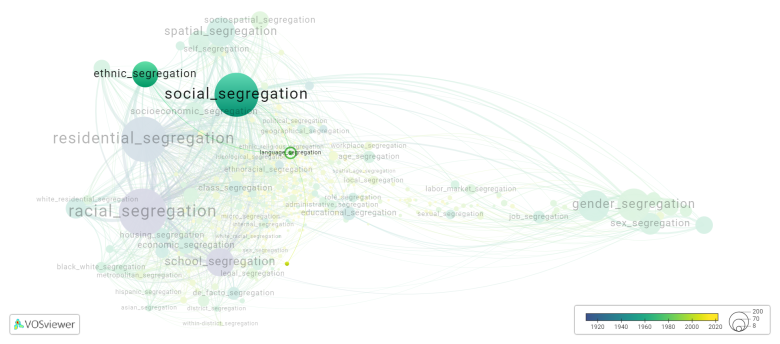Language segregation: Difference between revisions
(Creating page) |
(Creating page) |
||
| (2 intermediate revisions by the same user not shown) | |||
| Line 6: | Line 6: | ||
Language segregation refers to the separation or division of people based on the language they speak. This can manifest in various forms, such as discrimination in employment or housing based on language proficiency, the establishment of separate schools or communities for speakers of different languages, or the exclusion of certain language speakers from social or economic opportunities. Language segregation can create barriers to communication and integration, leading to social division and inequality. It is important to promote language diversity and ensure that all individuals have equal access to opportunities regardless of the language they speak. | Language segregation refers to the separation or division of people based on the language they speak. This can manifest in various forms, such as discrimination in employment or housing based on language proficiency, the establishment of separate schools or communities for speakers of different languages, or the exclusion of certain language speakers from social or economic opportunities. Language segregation can create barriers to communication and integration, leading to social division and inequality. It is important to promote language diversity and ensure that all individuals have equal access to opportunities regardless of the language they speak. | ||
===== Synonyms ===== | ===== Synonyms ===== | ||
The following terms are synonymous with: | The following terms are synonymous with language segregation: | ||
language based segregation. | language based segregation. | ||
| Line 18: | Line 18: | ||
[[File:language_segregation.png|780x780px]] | [[File:language_segregation.png|780x780px]] | ||
This visualization is based on the study [[Segregation_Wiki:About| The Multidisciplinary Landscape of Segregation Research]]. | |||
For the complete network of | For the complete network of interrelated segregation forms, please refer to: | ||
* [https://tinyurl.com/2235lkhw First year of publication] | |||
* [https://tinyurl.com/2d8wg5n3 Louvain clusters] | |||
* [https://tinyurl.com/223udk5r Betweenness centrality] | |||
* [https://tinyurl.com/244d8unz Disciplines in which segregation forms first emerged (Scopus database).] | |||
==References== | ==References== | ||
==Notes== | ==Notes== | ||
Latest revision as of 07:17, 16 October 2024
Date and country of first publication[1][edit | edit source]
1990
United States
Definition[edit | edit source]
Language segregation refers to the separation or division of people based on the language they speak. This can manifest in various forms, such as discrimination in employment or housing based on language proficiency, the establishment of separate schools or communities for speakers of different languages, or the exclusion of certain language speakers from social or economic opportunities. Language segregation can create barriers to communication and integration, leading to social division and inequality. It is important to promote language diversity and ensure that all individuals have equal access to opportunities regardless of the language they speak.
Synonyms[edit | edit source]
The following terms are synonymous with language segregation:
language based segregation.
References and literature addressing this segregation form under these synonymous terms can be found below.
See also[edit | edit source]
Related segregation forms[edit | edit source]
Language segregation is frequently discussed in the literature with the following segregation forms:
ethnic segregation, social segregation, religious segregation, american school segregation

This visualization is based on the study The Multidisciplinary Landscape of Segregation Research.
For the complete network of interrelated segregation forms, please refer to:
References[edit | edit source]
Notes[edit | edit source]
- ↑ Date and country of first publication as informed by the Scopus database (December 2023).
At its current state, this definition has been generated by a Large Language Model (LLM) so far without review by an independent researcher or a member of the curating team of segregation experts that keep the Segregation Wiki online. While we strive for accuracy, we cannot guarantee its reliability, completeness and timeliness. Please use this content with caution and verify information as needed. Also, feel free to improve on the definition as you see fit, including the use of references and other informational resources. We value your input in enhancing the quality and accuracy of the definitions of segregation forms collectively offered in the Segregation Wiki ©.
Language segregation appears in the following literature[edit | edit source]
Imhoff G. (199). The Position of U.S. English on Bilingual Education. The ANNALS of the American Academy of Political and Social Science, 508(1), 48-61. https://doi.org/10.1177/0002716290508001005
Donato R., Garcia H. (1991). Language segregation in desegregated schools:A question of equity. Equity and Excellence in Education, 25(2-4), 94-99. https://doi.org/10.1080/1066568910250214
Castelló X., Loureiro-Porto L., Miguel M.S. (2013). Agent based models of language competition. International Journal of the Sociology of Language, 21-51. Walter de Gruyter GmbH.https://doi.org/10.1515/ijsl-2013-0022
Corvalan A., Vargas M. (2015). Segregation and conflict: An empirical analysis. Journal of Development Economics, 116(), 212-222. Elsevier.https://doi.org/10.1016/j.jdeveco.2015.05.002
Santiago M. (2019). Historical Inquiry to Challenge the Narrative of Racial Progress. Cognition and Instruction, 37(1), 93-117. Routledge.https://doi.org/10.1080/07370008.2018.1539734
Astapova A. (2022). An Estonian Russian Language Club as a Venue for Grassroots Ethnic Integration. Nationalities Papers, 50(3), 498-514. Cambridge University Press.https://doi.org/10.1017/nps.2021.8
